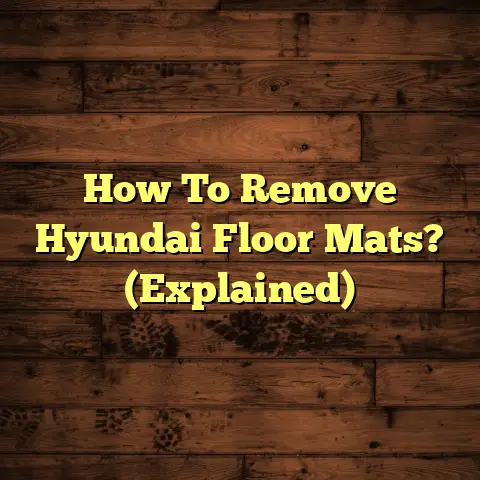Cat Pee Smell In Wood: Fix It! (In 3 Steps?)
Ever walked into a home and been hit with that unmistakable, pungent odor of cat pee?
It’s a common problem, and if you’re dealing with it in your own home, you know how frustrating it can be.
Imagine this: a cozy living room, family photos on the mantle, a purring cat curled up on the sofa. But lurking beneath the surface is that lingering scent, clinging to your beautiful wood floors.
It’s not just unpleasant; it can impact your home’s value and even affect your pet’s behavior.
I’ve seen it all in my years as a flooring contractor.
I’ve helped countless homeowners reclaim their homes from this smelly situation.
The good news? You don’t have to live with it.
I’m going to walk you through a proven three-step process to not only eliminate the odor but also restore your wood floors to their former glory.
Think of a home that smells fresh and inviting, where you and your furry friends can live in harmony, free from unpleasant odors.
That’s what we’re aiming for, and it’s absolutely achievable.
Let’s dive in and get your home smelling amazing again!
Step 1: Identify the Source of the Odor
Okay, first things first: detective work!
Before you even think about cleaning or repairing, you’ve got to pinpoint exactly where that cat pee smell is coming from.
I can’t stress this enough – haphazard cleaning is a waste of time and effort.
Trust me, I’ve seen homeowners scrub their entire floor only to realize the culprit was a tiny spot hidden under the rug.
So, where do cats typically do their business on wood floors?
Think about these common areas:
- Near the litter box: Accidents happen, especially if the box isn’t cleaned regularly.
- Favorite resting spots: Cats often mark their territory where they feel comfortable.
- Areas of anxiety: Stress can lead to inappropriate urination. Is there a new pet, a recent move, or construction nearby?
Now, for the fun part: finding the hidden stains.
Here are a few methods I swear by:
- Blacklight Test: This is my go-to. Get a UV flashlight (you can find them online for around \$10-\$20). Turn off the lights, and scan the floor. Cat urine will glow a yellowish-green color. It’s like CSI for your floors!
- Sniff Test: Yep, you read that right. Get down on your hands and knees (don’t be shy!) and sniff around the suspected areas. Fresh urine will have a stronger ammonia smell. I know it’s not glamorous, but it works.
- Moisture Meter: If you suspect urine has seeped deep into the wood, a moisture meter can help. Normal wood moisture content is around 6-12%. Higher readings in specific areas could indicate urine saturation. These can be a bit pricey (around \$50-\$200), but they’re useful for persistent problems.
I remember one client, Mrs. Davis, who was convinced her entire living room floor was ruined.
After a thorough blacklight inspection, we discovered the culprit was a tiny spot behind the sofa, barely visible to the naked eye.
She was so relieved it wasn’t as bad as she thought!
Speaking of damage, while you’re searching, keep an eye out for these signs:
- Warping: Urine can cause wood to swell and warp over time.
- Discoloration: Look for dark stains or bleached-out areas.
- Soft spots: Press down on the wood. If it feels spongy or gives way easily, the urine has likely damaged the fibers.
Why is all this detective work so important?
Because knowing the extent of the damage will determine the best course of action.
A small, surface stain might only require cleaning, while deep saturation could necessitate sanding or even replacing the affected boards.
Think of it like this: you wouldn’t treat a cold with surgery, right?
Same goes for cat pee on wood floors.
Understanding the root of the issue is crucial for effective remediation.
It sets the stage for the next steps and ensures you’re not wasting time and money on solutions that won’t work.
So, grab your blacklight, get sniffing, and let’s get to the bottom of this!
Once you know what you’re dealing with, we can move on to the cleaning and treatment phase.
Step 2: Clean and Treat the Affected Area
Alright, you’ve located the crime scene. Now it’s time to clean up!
This step is all about neutralizing the odor and preventing it from coming back.
I’m going to walk you through the best cleaning methods, step-by-step.
But first, let’s gather our supplies. You’ll need:
- Enzymatic Cleaner: This is non-negotiable. Enzymatic cleaners contain enzymes that break down the uric acid in cat urine, which is what causes the lingering smell. Regular cleaners simply mask the odor, while enzymatic cleaners eliminate it at the source. I recommend brands like Nature’s Miracle, Anti-Icky-Poo, or Rocco & Roxie Stain & Odor Eliminator. They’re specifically formulated for pet messes and are safe for wood floors when used as directed.
- White Vinegar: A natural disinfectant and odor neutralizer. It’s also safe for wood floors in diluted form.
- Baking Soda: Another natural odor absorber. It’s great for drawing out moisture and smells from porous surfaces.
- Hydrogen Peroxide (3%): Use with caution! It can lighten wood, so test it in an inconspicuous area first. It’s effective for breaking down stains, but always dilute it with water (1 part peroxide to 2 parts water).
- Paper Towels or Microfiber Cloths: For blotting and wiping.
- Spray Bottle: For applying cleaners.
- Soft-Bristled Brush: For gentle scrubbing.
- Gloves: To protect your hands.
Now, let’s get cleaning! Here’s my step-by-step guide:
- Preparation:
- Blot up any fresh urine with paper towels immediately.
- Remove any rugs or furniture from the affected area.
- Open windows and doors to ventilate the room.
- Apply Enzymatic Cleaner:
- Follow the manufacturer’s instructions carefully.
- In general, you’ll want to saturate the affected area with the cleaner.
- Don’t be afraid to really soak it – the enzymes need to reach the urine.
- Let it sit for the recommended time (usually 10-15 minutes).
- Blot, Don’t Rub:
- Use paper towels or a clean microfiber cloth to blot up the cleaner.
- Avoid rubbing, as this can spread the urine and damage the wood.
- Vinegar Solution (Optional):
- If the odor persists, mix equal parts white vinegar and water in a spray bottle.
- Lightly spray the affected area and let it sit for 5-10 minutes.
- Blot up with a clean cloth.
- Baking Soda Treatment:
- Sprinkle a generous amount of baking soda over the affected area.
- Let it sit overnight (or even longer for stubborn odors).
- Vacuum up the baking soda the next day.
- Hydrogen Peroxide (Use with Caution!):
- If the stain is still visible, try a diluted hydrogen peroxide solution.
- Test it in an inconspicuous area first to make sure it doesn’t lighten the wood too much.
- Apply the solution with a cotton ball, let it sit for a few minutes, and blot up with a clean cloth.
- Drying:
- Allow the area to air dry completely.
- You can use a fan to speed up the process.
- Make sure the wood is completely dry before replacing any rugs or furniture.
I know it sounds like a lot of steps, but trust me, it’s worth it.
The key is to be thorough and patient.
Enzymatic cleaners are your best friend in this situation.
They don’t just mask the odor; they actually break down the uric acid crystals that cause it.
That’s why they’re so much more effective than regular cleaners.
I’ve had clients tell me they’ve tried everything, from bleach to Febreze, with no luck.
Then they try an enzymatic cleaner, and the odor is gone!
One thing I always emphasize is ventilation.
Open those windows!
The fresh air will help to dissipate the odor and speed up the drying process.
Plus, it’s just healthier for you and your pet.
Now, let’s talk about common mistakes.
Here are a few things to avoid:
- Using Steam Cleaners: Steam can drive the urine deeper into the wood and make the problem worse.
- Using Ammonia-Based Cleaners: Cat urine contains ammonia, so using ammonia-based cleaners can actually attract your cat back to the same spot.
- Rubbing Too Hard: This can damage the wood finish and spread the urine.
- Not Letting the Cleaner Sit Long Enough: The enzymes need time to work their magic.
Remember, patience is key.
It may take several applications of the enzymatic cleaner to completely eliminate the odor.
But don’t give up!
With a little elbow grease and the right products, you can get your wood floors smelling fresh and clean again.
Step 3: Repair and Restore the Wood
Okay, you’ve cleaned and treated the affected area, but what if the urine has caused lasting damage?
That’s where repair and restoration come in.
Depending on the severity of the damage, you might need to sand, refinish, or even replace the affected boards.
Let’s start with sanding.
This is a good option if the urine has only penetrated the surface of the wood.
Here’s what you’ll need:
- Orbital Sander: For removing the old finish and urine-soaked wood.
- Sandpaper (various grits): Start with a coarse grit (60-80) to remove the finish, then move to a medium grit (100-120) to smooth the surface, and finish with a fine grit (180-220) for a smooth finish.
- Dust Mask: Protect your lungs from dust.
- Safety Glasses: Protect your eyes from flying debris.
- Vacuum Cleaner: For removing dust.
- Tack Cloth: For wiping down the surface before applying the finish.
Here’s how to sand your wood floors:
- Preparation:
- Clear the room of all furniture and rugs.
- Cover any remaining surfaces with plastic sheeting to protect them from dust.
- Open windows and doors to ventilate the room.
- Wear a dust mask and safety glasses.
- Sanding:
- Start with the coarse grit sandpaper and sand in the direction of the wood grain.
- Overlap each pass by about 50% to ensure even sanding.
- Vacuum up the dust frequently.
- Repeat with the medium and fine grit sandpaper.
- Cleaning:
- Vacuum up all the dust.
- Wipe down the surface with a tack cloth to remove any remaining dust.
Once you’ve sanded the floor, you’ll need to refinish it to protect the wood and give it a beautiful shine.
Here’s what you’ll need:
- Wood Stain (optional): To change the color of the wood.
- Wood Finish (polyurethane, varnish, or lacquer): To protect the wood from wear and tear.
- Paint Brush or Roller: For applying the stain and finish.
- Mineral Spirits: For cleaning brushes and rollers.
Here’s how to refinish your wood floors:
- Staining (optional):
- Apply the stain evenly with a brush or roller.
- Let it sit for the recommended time (usually 5-10 minutes).
- Wipe off the excess stain with a clean cloth.
- Let the stain dry completely (usually 24 hours).
- Applying the Finish:
- Apply the finish evenly with a brush or roller.
- Let it dry completely (usually 24 hours).
- Lightly sand the finish with fine grit sandpaper to smooth out any imperfections.
- Apply a second coat of finish.
- Let it dry completely.
- Curing:
- Allow the finish to cure completely (usually 72 hours) before replacing any furniture or rugs.
Now, what if the urine has caused more severe damage, like warping or soft spots?
In that case, you might need to replace the affected boards.
This is a more involved process, but it’s often the only way to completely eliminate the odor and restore the integrity of the floor.
I always recommend hiring a professional for this type of repair, as it requires specialized tools and skills.
But if you’re feeling ambitious, here’s a general overview of the process:
- Remove the Damaged Boards:
- Use a chisel and hammer to carefully remove the damaged boards.
- Be careful not to damage the surrounding boards.
- Prepare the Subfloor:
- Clean the subfloor and make sure it’s level.
- Install new furring strips if necessary.
- Install the New Boards:
- Cut the new boards to the correct size.
- Apply adhesive to the subfloor and the edges of the new boards.
- Nail the new boards into place.
- Sand and Finish:
- Sand the new boards to blend them in with the existing floor.
- Apply stain and finish to match the existing floor.
No matter which repair method you choose, it’s important to take preventative measures to protect your wood floors from future accidents.
Here are a few tips:
- Clean Litter Boxes Regularly: A clean litter box is less likely to be rejected by your cat. The general rule is one litter box per cat, plus one extra.
- Provide Plenty of Water: Dehydration can lead to concentrated urine, which is more damaging to wood floors.
- Address Anxiety Issues: If your cat is urinating due to anxiety, talk to your veterinarian about possible solutions, such as medication or behavioral therapy.
- Use Waterproof Mats: Place waterproof mats under litter boxes, food bowls, and other areas where your cat is likely to have accidents.
- Consider a Pet Insurance: It can help cover the costs of vet visits and behavioral therapy. According to the North American Pet Health Insurance Association (NAPHIA), the average accident and illness insurance premium for cats in 2022 was \$343 per year.
Remember, restoring your wood floors is an investment in your home and your quality of life.
It’s not just about eliminating the odor; it’s about creating a clean, healthy, and beautiful space for you and your furry friends to enjoy.
Conclusion
So, there you have it: a comprehensive guide to fixing cat pee smell in wood floors.
We’ve covered everything from identifying the source of the odor to cleaning, treating, and repairing the affected area.
Let’s recap the three steps:
- Identify the Source: Use a blacklight, sniff test, and moisture meter to pinpoint the exact location of the urine.
- Clean and Treat: Use an enzymatic cleaner, vinegar, and baking soda to neutralize the odor and break down the urine.
- Repair and Restore: Sand, refinish, or replace damaged boards to restore the integrity of the floor.
I know it can seem like a daunting task, but trust me, it’s worth it.
Imagine walking into your home and being greeted by a fresh, clean scent, instead of that lingering cat pee odor.
Think of the peace of mind knowing that your wood floors are protected from future accidents.
Picture your cat happily lounging on the sofa, without the urge to mark its territory.
It’s all possible!
The key is to take action.
Don’t let the cat pee smell linger any longer.
Take the first step today and start reclaiming your space.
Whether you choose to tackle the project yourself or hire a professional, the important thing is to get started.
Your home is your sanctuary, and it should be a place where you feel comfortable, relaxed, and happy.
Don’t let a little cat pee stand in the way of that.
So, grab your blacklight, gather your supplies, and let’s get to work!
I’m confident that with a little effort, you can transform your home from a smelly situation to a fresh and pleasant environment.
And remember, a happy home is a home where both cats and humans can live in harmony.





